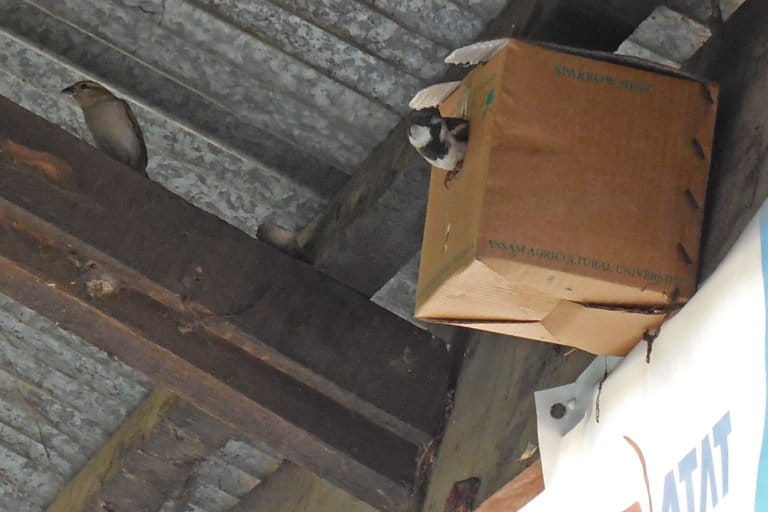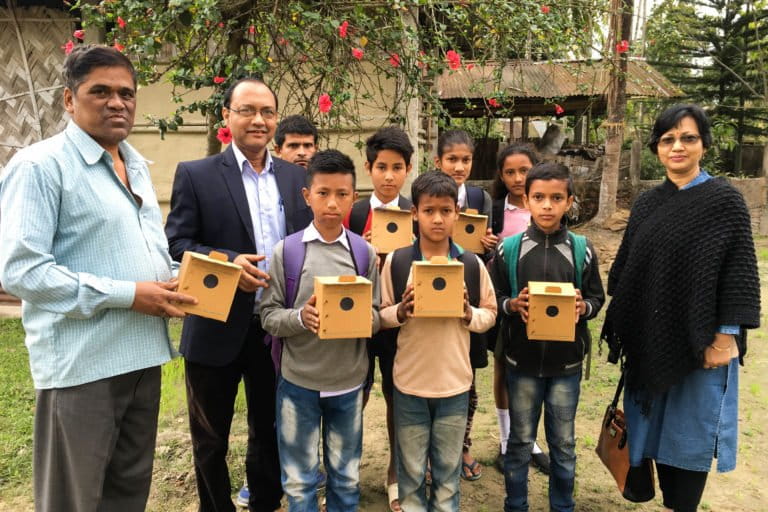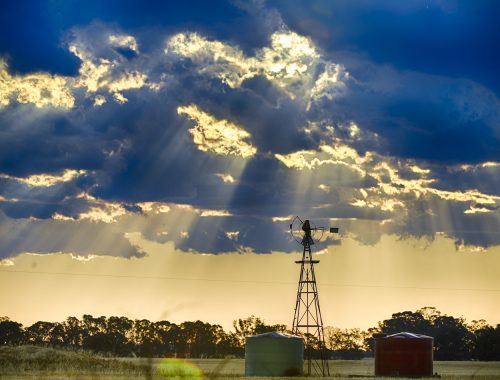by Kasturi Das
- Across Assam, villages have embarked upon a mission to save the house sparrow, by using a simple, low-cost solution: nest boxes made of cardboard.
- After a state-wide survey in 2009 showed rapid decline of the sparrow population, Prabal Saikia from the Assam Agricultural University, designed a low-cost nest box and started distributing them for free.
- Over the past decade, Saikia has distributed over 20,000 boxes for free in villages across Assam.
- As a forerunner to World Sparrow Day on March 20, Mongabay-India brings you this heart-warming tale of entire villages taking sparrows into their hearts.
All the 65 households at Borbali Samua, a little village in the Lakhimpur district of Assam, share their homes with a chirpy, industrious, oft-beleaguered creature: the house sparrow.
Forty-seven-year-old Jayanta Neog, the owner of a rice mill, is one of the principal conservators of the sparrow in this village. He goes around the village, educating the people and children about the importance of the sparrow. On a tour around Neog’s house, one can spot various kinds of artificial bird nests – made of cardboard, wood, shoeboxes and even bamboo.
“We had noticed that there were quite a number of sparrows in the village, but there was a lack of shelter because of new infrastructure — people are now starting to build concrete houses instead of the traditional mud houses,” said Neog, who has been working for conserving the sparrows, since 2013.
The house sparrow (Passer domesticus), one of the most commonly found bird species in urban as well as rural areas in India, is facing an uncertain future. Its number is declining and experts fear that the disappearance of the bird would mean a bleak future for farms and farmers. Apart from feeding on seeds, the bird also thrives on tiny insects and pests.
This social bird, often found in groups of eight to ten, has learned to live in close contact with humans and has coexisted peacefully with humans for years. But the last two decades have seen a steep decline in its population.

A species on the decline
Meanwhile, Prabal Saikia, the chief scientist at the Regional Agricultural Research Station (RARS), Assam Agricultural University at North Lakhimpur, had conducted an extensive survey in 2009. The findings were disheartening; the population of the house sparrow was fast declining.
“The decline of the house sparrow is an indicator of the continuous degradation of the environment around us,” said Saikia. “The house sparrow is believed to be declining for various reasons, ranging from the destruction of their habitat to lack of insects for the young, vanishing courtyards, cramped buildings, [and radiation] from phone towers. Their decline is an indicator of things going wrong in the space we live.”
To increase the population of the house sparrow, Saikia came up with a solution – low-cost cardboard nests. He believed that the population of the house sparrow could get a boost if low-cost nest boxes were popularised amongst the common people. He went on to design a low-cost nest box for sparrows and promoted it across Assam.
“The sparrow easily adapts to man-made nests and if they are promoted on a large-scale, it can lead to long-term conservation of the bird,” said Saikia. “Nest boxes are very easy to make and cost almost nothing. In our survey in several districts of Upper and Lower Assam, we have noticed substantial occupancy of the house sparrow in the low-cost nest boxes.”
The predator-proof nest boxes are made of cardboard and it costs around Rs. 10 to make one. In the past decade, Saikia has distributed over 20,000 boxes for free in villages across Assam.
“We are adopting villages and installing nest boxes in the village houses to support the remaining population of the house sparrow,” Saikia said. “We also encourage people to make use of waste, such as shoeboxes, to make nest boxes.”
“A little bit of love goes a long way.”
For the inhabitants of Borbali Samua, it is more than just conserving sparrows. One can feel the love and compassion they hold for the beleaguered bird by merely talking to these villagers.
“You’ll see these birds everywhere. They like to be around people. You eventually become involved in the life of these birds. You put up a nest for them, see them gathering twigs to build their nests, see them have young ones. A little bit of love goes a long way,” Neog said.
Our conversation was interrupted by a group of school children who arrived at Neog’s doorstep seeking bird boxes.
“The cardboard nests given to us by Dr. Saikia have been distributed in every household. We put up quite a number of boxes and we gradually saw an increase in the population of the sparrow. People who visit us also take away those boxes. They are quite in demand,” said Neog, while assembling a few for the children.

The children in Borbali Samua are sensitised at an early age. Caring for and protecting the house sparrow and other wildlife is something that has been ingrained in them. They often attend awareness meetings and have workshops in their school and have learned the importance of conservation of nature around them.
“We have held meetings in schools in and around the village. I think we have been largely successful in our endeavour,” Neog said with a glint of pride in his eyes. Neog was conferred an award by the RARS in 2018, along with six others from various villages in Assam, for their exceptional efforts in conservation of the house sparrow.
Ever since 2009, Saikia has been conducting awareness programmes throughout the length and breadth of the state. This year, the Krishi Vigyan Kendras of the Assam Agricultural University will be observing the World Sparrow Day in 23 districts in Assam.
Saikia claims to have seen a tremendous shift of awareness amongst the common people, in the past decade, regarding the need to conserve wildlife. “I have always maintained that it is only the common man that can save the sparrow, the common bird,” he said, adding that, “It is the need of the hour to start habitat conservation drives by switching to organic gardening, planting hedges and putting up artificial nest boxes dedicated to house sparrows.” (Source: Mongabay)




